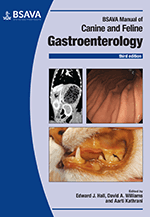
Full text loading...

This chapter describes the structure and function of the vasculature of the liver, and the pathophysiology, diagnosis and management of vascular disease.
Liver: vascular disorders, Page 1 of 1
< Previous page | Next page > /docserver/preview/fulltext/10.22233/9781910443361-3e/BSAVA_Manual_Gastroenterology_3_9781910443361-3e.37b.268-276-1.gif

Full text loading...








